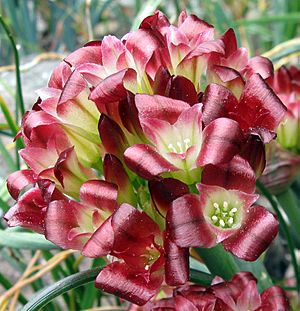Spanish Needle onion facts for kids
Quick facts for kids Spanish Needle onion |
|
|---|---|
 |
|
| Allium shevockii | |
| Scientific classification |
The Spanish Needle onion (Allium shevockii) is a special kind of wild onion. It's quite rare, meaning there aren't many of them around. You can only find this unique plant in a small part of the southern Sierra Nevada mountains in California.
What Does the Spanish Needle Onion Look Like?
The Spanish Needle onion grows from a bulb that's about 1 to 1.5 centimeters wide. That's roughly the size of a small marble! Sometimes, this main bulb also has one or two smaller "baby" bulbs, called bulblets, growing from it.
From the bulb, a tall stem, called a stipe, grows upwards. At the very top of this stem, you'll find a cluster of flowers. This cluster is shaped like an umbrella and is called an umbel.
Each plant can have up to 30 flowers in its umbel. Each flower is just over a centimeter wide. They have six shiny petals, which are actually called tepals in plants like onions. These tepals can be a deep maroon or a rich pink color. They might also be white near their bases.
What makes this onion unique is how its tepals look. They are "reflexed," which means they curl outwards away from the center of the flower. It's like they are bending backward!
Where Does the Spanish Needle Onion Live?
This plant is endemic to southern California. This means it naturally grows only in this specific area and nowhere else in the world.
You can find known groups of these plants in the mountains of Kern County, California. They grow in places like Spanish Needle Peak and Horse Canyon. The plants on Spanish Needle Peak are located north of Owens Peak in the Sierra Nevada. This area is close to the borders of Tulare and Inyo Counties.

